

Two Research Fellow and one Electronics Engineer position in Quantum Device Engineering - Academic Positions. Applications are invited for two positions as Research Fellow and one as Electronics Engineer in Quantum Device Engineering in the Ion Quantum Technology Group at the Sussex Centre for Quantum Technologies in the Department of Physics & Astronomy at the University of Sussex.
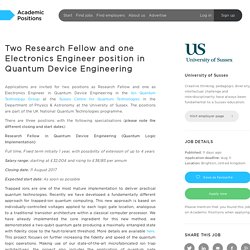
The positions are part of the UK National Quantum Technologies programme. There are three positions with the following specialisations (please note the different closing and start dates): Research Fellow in Quantum Device Engineering (Quantum Logic Implementation) Full time, Fixed term initially 1 year, with possibility of extension of up to 4 years Salary range: starting at £32,004 and rising to £38,183 per annum Closing date: 11 August 2017 Expected start date: As soon as possible. Quantum Computing Is Going Commercial With the Potential to Disrupt Everything. Consider three hair-pulling problems: 1 percent of the world’s energy is used every year just to produce fertilizer; solar panels aren’t powerful enough to provide all the power for most homes; investing in stocks often feels like a game of Russian roulette.

Those seemingly disparate issues can be solved by the same tool, according to some scientists: quantum computing. Quantum computers use superconducting particles to perform tasks and have long been seen as a luxury for the top academic echelon—far removed from the common individual. But that’s quickly changing. IBM had been dabbling with commercial possibilities when last year it released Quantum Experience, a cloud-based quantum computing service researchers could use to run experiments without having to buy a quantum system. In early March, IBM took that program further and announced IBM Q, the first cloud quantum computing system for commercial use.
Besting supercomputers. Quantum Computers Compete for "Supremacy" Scientists have long dreamed of developing quantum computers, machines that rely on arcane laws of physics to perform tasks far beyond the capability of today’s strongest supercomputers.
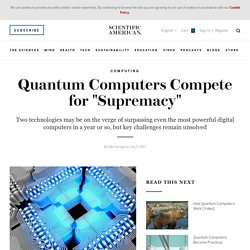
In theory such a machine could create mathematical models too complex for standard computers, vastly extending the range and accuracy of weather forecasts and financial market predictions, among other things. They could simulate physical processes such as photosynthesis, opening new frontiers in green energy. Quantum computing could also jolt artificial intelligence to a vastly higher level of sophistication: If IBM’s Watson can already win at Jeopardy! And make some medical diagnoses, imagine what an enormously smarter version could do.
Vérification de sécurité nécessaire. IBM Follows Up AI, Watson With Eyes Set on Quantum Computing. After laying the groundwork for offerings in emerging tech categories like artificial intelligence (see: Watson) and blockchain (see: Hyperledger and Fabric), IBM sees quantum computers as a big, if nascent, business opportunity.

Unlike traditional computers, quantum ones are designed to harness the wonkier properties of physics to perform far more complex operations. Whereas a conventional computer stores information as "bits" in two states—1 equaling "on" or 0 as "off"—a quantum computer uses "qubits" to hold multiple states at the same time, thus unleashing the weird "superposition" property of quantum mechanical particles for exponential power. Since IBM (ibm, -0.57%) opened up access to its own fledgling quantum computing system to the public in May, approximately 40,000 people have run more than 275,000 experiments on it to date, the company said Monday. Quantum Cryptography Passes Another Critical Test. On a clear night last September, at a little Ontario airport, two pilots, two scientists, and an engineer took off in a small plane.
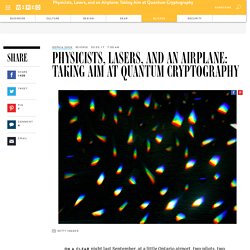
They’d pulled the left-side door off its hinges, and a telescope poked out of the portal—not at the night sky, but at the ground below. The team was about to play a very difficult, very windy game of catch. A couple miles away, their colleagues gathered in a trailer to lob the tiny baseballs: infrared photons, beamed from a laser that tracked the plane along its mile-high trajectory. In the craft cruising above, physics graduate student Chris Pugh and the others pivoted their telescope to catch the photons, one by one. On their best run, they caught over 800,000 photons in just a few minutes, but it wasn’t easy. National Quantum Technologies Showcase. Naked Scientists Podcast Player. Has The Age Of Quantum Computing Arrived? - Disruption. Q&A - Catching Gravitational Waves - with Sheila Rowan. Sorry, Einstein. Quantum Study Suggests ‘Spooky Action’ Is Real. Photo In a landmark study, scientists at the Delft University of Technology in the Netherlands reported they have conducted an experiment they say proves one of the most fundamental claims of quantum theory — that objects separated by great distance can instantaneously affect each other’s behavior.

The finding is another blow to one of the bedrock principles of standard physics known as “locality,” which states that an object is directly influenced only by its immediate surroundings. The Delft study, published Wednesday in the journal Nature, lends further credence to an idea that Einstein famously rejected. Quantum Computers One Step Closer After Australian Breakthrough. Engineers from the University of New South Wales, Australia, have made an important breakthrough that brings quantum computers one step closer to reality.
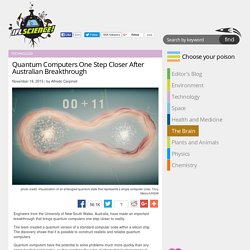
The team created a quantum version of a standard computer code within a silicon chip. The discovery shows that it is possible to construct realistic and reliable quantum computers. Quantum computers have the potential to solve problems much more quickly than any computer that exists today, as they combine the rules of informatics to phenomena of quantum mechanics that are not observed in everyday life. Namely, the principle of superposition, popularized by Schrödinger’s cat being both alive and dead, and entanglement.
Google's Quantum Computer Just Got a Big Upgrade. Google is upgrading its quantum computer.
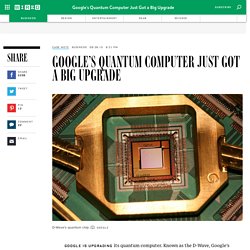
Known as the D-Wave, Google’s machine is making the leap from 512 qubits—the fundamental building block of a quantum computer—to more than a 1000 qubits. And according to the company that built the system, this leap doesn’t require a significant increase in power, something that could augur well for the progress of quantum machines. Together with NASA and the Universities Space Research Association, or USRA, Google operates its quantum machine at the NASA Ames Research center not far from its Mountain View, California headquarters. Consciousness & quantum physics ~ Reality is an illusion. University of Glasgow’s Professor Douglas Paul among leading researchers to share £12 million investment from EPSRC. GLASGOW, 29-9-2015 — /EuropaWire/ — The University of Glasgow’s Professor Douglas Paul has been announced as one of a series of leading researchers who will share in a £12 million investment from the Engineering and Physical Sciences Research Council (EPSRC).
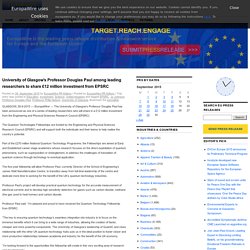
New quantum dot could make quantum communications possible. A new form of quantum dot has been developed by an international team of researchers that can produce identical photons at will, paving the way for multiple revolutionary new uses for light.
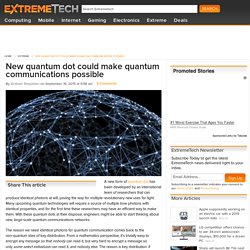
Many upcoming quantum technologies will require a source of multiple lone photons with identical properties, and for the first time these researchers may have an efficient way to make them. With these quantum dots at their disposal, engineers might be able to start thinking about new, large-scale quantum communications networks. The reason we need identical photons for quantum communication comes back to the non-quantum idea of key distribution. From a mathematics perspective, it’s trivially easy to encrypt any message so that nobody can read it, but very hard to encrypt a message so only some select individuals can read it, and nobody else. The reason is key distribution: if everybody who needs to decrypt a message has the associated key needed for decryption, then no problem. An international blog series from ATLAS. More than 3000 scientists from all over the world, including about 1000 graduate students, collaborate on the ATLAS experiment – an all-purpose detector on the Large Hadron Collider (LHC).
QUANTUM PHYSICS 2. A quick look at accelerators. The LHC: a unique tool The Large Hadron Collider (LHC) is a particle accelerator based at CERN, the European Organization for Nuclear Research, the world's largest particle physics laboratory. It is designed to be the most powerful instrument ever built to investigate the properties of fundamental particles. The LHC is located in a 26.658 km long tunnel, about 100m underground. It will accelerate two separate beams of protons travelling in opposite directions at up to an energy of 7 TeV.
What is a Quantum Computer and How Does it work. QUANTUM PHYSICS 2.